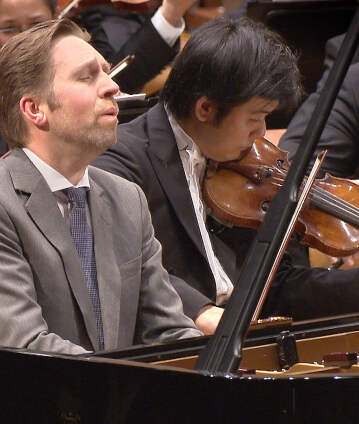Andrés Orozco-Estrada and Leif Ove Andsnes

Although Sergei Rachmaninov was of a melancholic disposition, his Fourth Piano Concerto is full of colour and spontaneity, qualities that pianist Leif Ove Andsnes brings out in his transparent, sinewy performance from May 2017. The virtuoso programme also included Richard Strauss’s Macbeth and Shostakovich’s Symphony No. 5. Making his debut conducting the Berliner Philharmoniker was Andrés Orozco-Estrada.
When Sergei Rachmaninov played the solo part of his Fourth Piano Concerto on 8 December 1930 with the Philharmonic in Berlin conducted by Bruno Walter, the highly complex work had already been revised twice. When the hoped-for success also failed to materialise in the German capital city, another revision followed; the correction process dragged on, however, since Rachmaninov, who had advanced to become one of the most sought-after and best-paid piano virtuosos in American exile, used every free minute to play concerts: “The blood vessels on my fingers have begun to burst; bruises are forming.” What the audience then heard at the belated premiere of the third and last concert version on 17 October 1941 (Eugene Ormandy conducting the Philadelphia Orchestra), had little to do with the rest of Rachmaninov’s late work, which is preponderantly gloomy and subdued: instead, it was spontaneous and full of strong colours. Moreover, the work, which is permeated with delicate lyricism, proved to be extremely innovative since, for the first time in the history of the concerto genre, each of the three movements is structured as an artfully through-composed variation form. The Berliner Philharmoniker present Rachmaninov’s Fourth Piano Concerto with the Norwegian pianist Leif Ove Andsnes, Philharmonic Artist in Residence in the 2010/11 season, whom the New York Times has called “a pianist of magisterial elegance, power, and insight”.
The conductor is the Colombian Andrés Orozco-Estrada, trained in Vienna, who is giving his Philharmonic debut at this concert. After all, the current head of the Frankfurt Radio Symphony, who is also music director of the Houston Symphony and first guest conductor of the London Philharmonic Orchestra, is among the most promising orchestra heads of the younger generation: already in 2004, when Andrés Orozco-Estrada first gained international attention by stepping in at short notice with the Tonkünstler-Orchester Niederösterreich in the Viennese Musikverein, he was celebrated by the press as the “miracle of Vienna”. After the interval, Andrés Orozco-Estrada programmed Shostakovich’s Fifth Symphony, a work which generated euphoria from the premiere audience in Leningrad: “When the thunderous applause shook the columns of the Philharmonic Hall, [the conductor Yevgeny] Mravinsky held up the score over his head, as if to say that these ovations were not due to him and not to the orchestra, but to the creator of this music – Shostakovich.” (Alexander Glumov)
© 2017 Berlin Phil Media GmbH
Related interviews